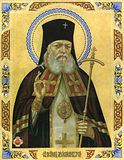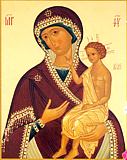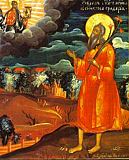

| Previous day | Next day |
| Old Style
March 5
|
Friday |
New Style
March 18
|
|
2nd Week of Great Lent.
Tone 5.
Great Lent. |
Monastic rule: xerophagy (bread, uncooked fruits and vegetables).
|
![]() Martyr Conon of Isauria (1st c.).
Martyr Conon of Isauria (1st c.). ![]() Translation of the relics of St. Theodore, prince of Smolensk and Yaroslavl, and his children Sts. David and Constantine (1463).
Translation of the relics of St. Theodore, prince of Smolensk and Yaroslavl, and his children Sts. David and Constantine (1463).
Martyr Onisius of Isauria (1st c.). Martyr Conon the Gardener, of Pamphylia (3rd c.). St. Mark the Faster, of Egypt (5th c.). St. Hesychius the Faster, of Bithynia (ca. 790). Monk-martyr Adrian (1550), founder of Poshekhonye Monastery (Rostov), and his fellow-ascetic St. Leonid (1549). Virgin-martyr Irais (Rhais) of Antinoe in Egypt. Martyr Eulogius of Palestine. Martyr Eulampius of Palestine. Sts. Basil (1249) and Constantine (1257), princes of Yaroslavl.
New Hieromartyrs Theophan (Grafov), hierodeacon of Borisoglebsk Monastery (Vladimir) and Mardarius (Isaev), hieromonk, of Yurievskoe (Yaroslavl) (1938).
St. Theophilus, bishop of Caesarea in Palestine (200). Martyr Archelaus and 152 Martyrs in Egypt (ca. 308). St. Kieran (Ciaran) of Saighir, Munster (5th c.-6th c.). St. Virgil, archbishop of Arles (618). New Martyr John the Bulgarian, at Constantinople (1784). New Hieromartyr Parthenius, bishop of Didymoteichon in Thrace (1805). New Martyr George of Rapsana, at Larissa (1818). St. Nikolai (Velimirovich), bishop of Ochrid and Zhicha, Serbia (1956).
Repose of Metropolitan Cornelius of Novgorod (1698).
Thoughts for Each Day of the Year
According to the Daily Church Readings from the Word of God
By St. Theophan the Recluse

Friday.
My Spirit shall not always strive with man, for that he also is flesh (Gen. 6:3).[1] Man has two opposing forces inside, but one consciousness—the human being. The characteristics of this being are determined by his inclinations. If he sides with the Spirit, he is spiritual; if he sides with the flesh, he is fleshly. The spirit does not disappear altogether even from the fleshly, but it is enslaved, and has no voice. It becomes yoked, and serves the flesh like a slave serves its mistress, inventing all sorts of pleasures for it. Similarly, the flesh does not disappear from the spiritual, but it submits to the spirit and serves it. It loses its natural rights for food through fasting, its rights for sleep through vigil, for rest through continuous labour and weariness, for pleasing the feelings through seclusion and silence. Where the flesh reigns, God does not abide; for His organ of communication with man is the spirit, which is not given its due priority in the flesh. God’s approach is felt for the first time when the spirit begins to claim its own through the operation of the fear of God and one’s conscience. When consciousness and freedom also come to help, then God communicates with man and begins to dwell in him. From that moment on begins the inspiration of the soul, the flesh and of the entire inner and outer man, while God becomes all in all in him. By becoming spiritual, man is made divine. What a marvellous benefit, and how little it is remembered, valued and sought after!
[1]The Slavonic for Gen. 6:3 reads: My Spirit shall not eternally be scorned by men, because they are flesh.
Articles
 Martyr Onesimus of IsauriaThe Holy Martyr Onesimus (Onisius) lived in Palestine. |
 Martyr Conon the Gardener of PamphyliaThe saint suffered for his faith in Christ under the emperor Decius (249-251). |
 St. Mark the Ascetic of EgyptFrom his youth his fondest pursuit was the reading of Holy Scripture. It is said that he knew the whole Bible by heart. |
 St. Hesychius the Faster of BithyniaSaint Hesychius the Faster was born in the eighth century in the coastal city of Adrineia in Bithynia. |
 Martyr Eulogius of PalestineThe Holy Martyr Eulogius was a native of Palestine. |
 Martyr Eulampius of PalestineThe Holy Martyr Eulampius lived in Palestine. He was beheaded for his faith in Christ. |











